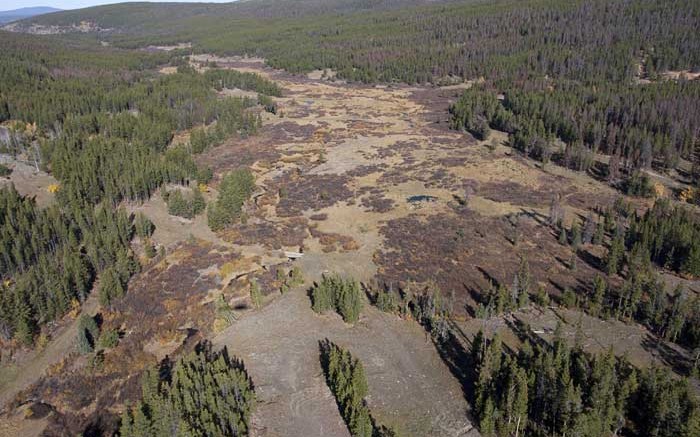VANCOUVER — Despite a $300-million adaptation to save Fish Lake, the Canadian government will not allow Taseko Mines (TSX: TKO; NYSE-MKT: TGB) to build a $1.5-billion open-pit copper–gold mine at its New Prosperity project in central B.C.
An earlier version of the planned Prosperity mine got a green light from provincial authorities in 2010, but the federal government turned it down, citing adverse and immitigable environmental impacts. Topping the list of adverse effects was the need to drain Fish Lake, also known as “Teztan Biny,” an area local First Nations describe as “sacred.”
Taseko was undeterred by the first rejection and recrafted the project. The result was a new mine plan that added $300 million to the price tag but saved Fish Lake.
Taseko submitted its New Prosperity plan for review in September 2012. A three-member review panel travelled around central B.C. for months last year, listening to expert testimony and local opinions on the new plan.
In a report issued in November, the review panel concluded the amended mine was still not in the best interests of Canadians. Three months later federal Environment Minister Leona Aglukkaq has officially agreed, denying Taseko permission to build the 70,000-tonne-per-day mine.
“The Minister of the Environment has concluded that the New Prosperity mine project is likely to cause significant adverse environmental effects that cannot be mitigated,” Aglukkaq’s office said in a statement. “The Governor in Council has determined that those effects are not justified in the circumstances. Therefore, the project may not proceed.”
Local Conservative Member of Parliament Dick Harris, not usually one to speak out against his party, decried the decision.
“This is a region that was completely devastated by the mountain pine beetle over the past ten years or so,” Harris said. “There have been lots of job losses. It was really struggling to find something to revive the economy, and all those hopes and dreams were pinned on the Prosperity mine to get operating.”
Local First Nations groups, on the other hand, who have vehemently opposed the project, applauded the decision.
“We are celebrating this decision to reject once again this terrible project, which threatened our pristine waters, fish and Aboriginal rights,” said Chief Joe Alphonse, Tribal Chair for the Tsilhqot’in national government. “We commend the federal government for not bowing to industry lobbying and instead respecting the science and independent process that came to the conclusion that this project would have devastating impacts on the environment, and our Nation’s ability to practice our rights in a sacred spiritual site.”
Taseko is appealing the review process that led to the permit denial because of what it claims are errors in the very science Alphonse mentions.
“The company fundamentally disagrees with the decision the federal government has made and believes they based their decision on a panel report that contains serious flaws,” Taseko said in a statement.
The flaws in question relate to a proposed tailings storage facility at New Prosperity. Taseko contends its facility would use a low-permeability, compact soil liner but that Natural Resources Canada (NRCan) mistakenly assessed a different design without a liner.
NRCan then determined the facility would readily leak tailings into the surroundings and testified as such to the review panel. Concern over tailings seepage played an important role in the panelists concluding that the project’s costs outweighed its benefits.
Taseko said it did not realize NRCan had assessed the wrong design until after the panel hearings. Once it did, the company moved to have the panel’s conclusions about tailings struck from its report by filing a federal judicial review. The judicial review also charges the panel failed to comply with principles of procedural fairness.
“At the panel hearings . . . there was never any reason to believe that an agency of the government of Canada could err so fundamentally as to apply its modelling to the wrong project design,” Taseko said at the time. “It was only upon reading the panel’s report and in particular the panel’s inexplicable reliance on the evidence of NRCan that Knight Piesold came to identify the extraordinary error that was made by NRCan and in turn the panel.”
The judicial review is underway and Taseko says it will fight for permission to build New Prosperity. While acknowledging that effort, Laurentian Bank Securities analyst Chris Chang thinks the company will also shift its focus elsewhere, in part because the odds of success are low at New Prosperity.
“Although Taseko plans to press on with an existing judicial review application to resume development plans for New Prosperity, we believe the company will likely focus its attention on alternative growth opportunities both organically and inorganically,” Chang wrote. “The company is advancing its Aley niobium project . . . while Aley could represent Taseko’s next growth vehicle, we believe Yellowhead Mining (TSX: YMI) and Curis Resources (TSX: CUV; US-OTC: PCCRF) remain on the company’s acquisition radar.”
Chang notes that Taseko already owns 10% of Yellowhead — which owns the large, development-stage Harper Creek copper–gold–silver project in south-central B.C. — and 17% of Curis, which is pushing the Florence in-situ recovery copper project in Arizona to production. Taseko hinted at the potential for an acquisition when it concluded its New Prosperity decision statement by saying the company “will take the necessary steps to protect this valuable asset, but at the same time will also look at other opportunities to increase shareholder value.”
The analyst still sees Taseko as a “good buy,” maintaining his target price of $3.80. After losing 12¢ on news of the New Prosperity permit denial, Taseko was trading at $2.25.
The company finished 2013 with $83 million in the bank. Production is ramping up at Taseko’s operating central B.C. mine, Gibraltar, where the company recently completed a six-year, $700-million expansion. The mine now churns through 85,000 tonnes of ore daily and sits on enough reserves to operate until 2039.


Be the first to comment on "Taseko denied New Prosperity"